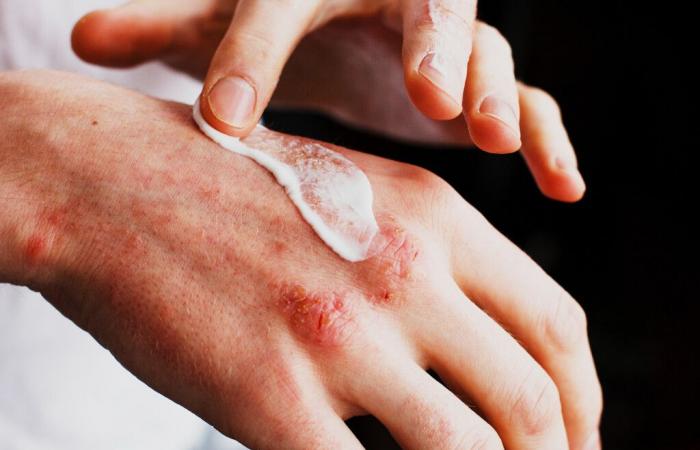On TikTok it has been common to talk about a condition called “topical steroid withdrawal” (in Portuguese, withdrawal from topical corticosteroids). There are several videos found on the social network sharing the supposed adverse effects of using this type of medication to treat conditions such as eczema.
Some users claim to have applied corticosteroids to their skin for years and, when they stopped treatment, they noticed a worsening of symptoms. What are topical corticosteroids and in what context are they prescribed? These drugs can cause withdrawal symptoms When do they stop being used?
What are topical corticosteroids?
Speaking to Viral, dermatologist Diana Miguel explains that corticosteroids Topical (or corticosteroids) are medications applied directly to the skin what “reduce inflammation and irritation”.
According to the doctor, “there are several topical corticosteroids available, with different strengths and formulations”.
As mentioned in a informative text of the British National Health System (NHS), topical corticosteroids are available in cream, lotiongel, ointment, strips and other solutions.
Some examples of corticosteroids mentioned by Diana Miguel are “hydrocortisone“, The “betamethasone” and the “clobetasol”.
Diana Miguel clarifies that topical corticosteroids “are common in the treatment of various skin conditions, such as eczema, dermatitis, psoriasis and other inflammatory diseases.”
As a rule, it is pointed out in a text from the National Eczema Association of the United States, topical corticosteroids “are recommended when the disease does not respond to traditional treatment. skin care and to moisturizers”.
Can stopping the use of topical corticosteroids worsen the skin condition?
Yes. According to Diana Miguel, “some people can develop Adverse reactions after stopping the use of topical corticosteroids, due to a phenomenon known as ‘Topical Steroid Withdrawal‘ (TSW)”.
This happens “when the body becomes dependent on corticosteroids to control skin inflammation and when use is abruptly discontinued”, he adds.
TSW can cause “withdrawal symptoms” or worsening of symptoms, “such as redness, edema, itching and more intense peeling” than that seen before treatment.
Diana Miguel highlights that this reaction is more common “in patients with chronic illnesses who rely heavily on use of topical corticosteroids”.
However, it can also occur “in all people who do prolonged and frequent use of topical corticosteroids, especially in higher concentrations and in very sensitive areas of the skin”.
Despite this, in the expert’s view, they are products “extremely important in clinical practice and people they should not be afraid to use them”.
In fact, the text from the National Eczema Association of the United States highlights that topical corticosteroids “continue to be the basis of treatment for adults and children with eczema” (see also here).
This is because, it is said, most people with eczema use topical corticosteroids as a treatment option. do not suffer adverse effects.
In the same sense, in a text of DermNet (a page that belongs to the New Zealand Dermatological Society), it is argued that “concerns about the risk of withdrawal from topical corticosteroids should not prevent adequate treatment of atopic dermatitis and other diseases of the skin”.
As highlighted in the text, there are many more people who respond well to use adequate use of topical corticosteroids than those who develop withdrawal.
What to do in case of adverse reactions after using topical corticosteroids?
In Diana Miguel’s view, “if a person presents symptoms of TSW, it is essential seek medical advice”.
This is because, although the symptoms of this type of reaction may lessen over time, “a doctor can recommend treatments for relieve symptoms and help with the recovery of skin”, highlights the dermatologist.
According to the DermNet text, there are still no specific treatments that reduce the duration of these reactions.
However, in general, it is common to prescribe: creams and moisturizers; cold compresses, ice and medication for burning pains; antihistamines for itching; simple painkillers; and sometimes psychological support is recommended.
The same text indicates that the duration of TSW, as a rule, varies between 72 hours and months, with most people recovers after three months. A small percentage of patients may have to deal with this adverse reaction for longer.
How to prevent adverse reactions and withdrawal symptoms?
In most cases, adverse reactions to topical corticosteroid withdrawal can be avoided.
With this goal in mind, “it is important follow medical instructions regarding the frequency and duration of use”, says Diana Miguel.
According to the doctor, “avoid excessive and prolonged use may also help reduce the risk of developing TSW.”
During treatment it is essential “apply the prescribed amount only on affected areas and avoid use on sensitive areas, such as the face.”
Finally, after treatment, it is essential “carry out proper weaning”, according to “the prescribed scheme”, he highlights. In some cases, it may be “recommended to switch to another topical anti-inflammatory, such as calcineurin inhibitors”, he concludes.






